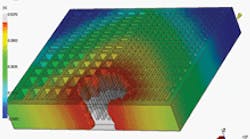Authored by: |
Since the inception of design-analysis software, there’s been a strong connection between the amount of computing power available and the way users mathematically model — or simulate — product designs. Several decades ago, when simulation first started to work its way into industry, there wasn’t enough computer power to support the technology’s potential. As a result, simulation was mainly limited to validation — software merely double-checked models to ensure specifications conformed with user needs and intended use.
Eventually, additional computing power let users also predict product behavior. Here, for instance, an analysis package might foretell the wind loads under which a bridge might fail. To harness extra computing power, simulation software used the graphics processing unit and CPU for numerical calculations, as well as distributed processing. However, this approach didn’t come cheaply. Companies typically had to purchase and maintain highend computer clusters to do their number crunching.
A more-recent, and logical, next step has been the trend towards cloud computing. This comprises Internet-based technologies that supply services, resources, software, and information. It provides the computer power to use simulation not only to validate designs and predict behavior, but to improve them as well.
Cloud computing is probably best suited for large analysis problems and complex design optimizations, which can involve dozens or even hundreds of iterations to consider each alternative in the parameter range. Users can upload these kinds of problems and continue to work locally.
An example of software that leverages cloud computing is the Inventor Optimization Technology Preview (it works in with Autodesk Inventor), found on Autodesk Labs. The program’s intuitive interface simplifies simulation set-up so a user can, for instance, reduce a design’s weight while raising its safety factor. The software performs multiple what-if scenarios behind the scenes, so to speak, in the cloud, letting engineers continue to do other work on their desktops. When results are ready, the software informs the user via e-mail. Because users are off-loading simulations, there is enough memory to handle the many different design configurations in parallel.
Cloud computing also works well in visualization. For example, Autodesk’s Project Neon Technology Preview creates photorealistic renderings powered by the cloud.
Better yet, cloud computing does not affect how engineers already work. After users follow the standard workflow for defining simulation parameters, they simply begin the simulation. The software connects with the cloud and transfers the necessary data. However, users do need to login, both for security and to ensure they can access appropriate resources. At this time, cloud-computing resources are provided at no additional cost as part of Autodesk’s free technology previews.
